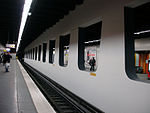Pavillon des Arts
Defunct museums in ParisMuseums disestablished in 2006
The Pavillon des Arts was a museum located in the 1st arrondissement of Paris at Les Halles, 101, rue Rambuteau, Paris, France. According to an article in Evene.fr, the museum closed in 2006. The museum was established in 1983 in a contemporary glass and steel building within Les Halles. Its exhibition space was devoted to temporary exhibits of photography, painting, sculpture, archaeology, objets d'art, jewellery, costumes, textiles, furniture, books, medals, and so forth.
Excerpt from the Wikipedia article Pavillon des Arts (License: CC BY-SA 3.0, Authors).Pavillon des Arts
Rue Rambuteau, Paris Quartier Les Halles (Paris)
Geographical coordinates (GPS) Address Nearby Places Show on map
Geographical coordinates (GPS)
| Latitude | Longitude |
|---|---|
| N 48.8625 ° | E 2.3477777777778 ° |
Address
Valege
Rue Rambuteau
75001 Paris, Quartier Les Halles (Paris)
Ile-de-France, France
Open on Google Maps








